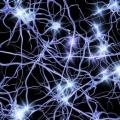
MS is associated with functional alteration of multiple nerve information transmission pathways in the CNS. Whereas demyelination is one of the cardinal elements of the disease, it is associated, very rapidly, with a loss of nerve fibres (axonopathy). In the acute phase, a conduction block decreases the speed of propagation of the nerve impulse, and it is difficult to detect a loss of nerve fibres. The development of conduction over time makes it possible to put things in perspective. Neurophysiological techniques (evoked potentials - EPs) make it possible to measure the conduction parameters of several central nervous pathways, afferent (to the cerebral cortex) or efferent (to the spinal cord).
Therapeutic trials have in recent years been conducted in humans with drugs that may provide neuroprotection or promote the remyelination of nerve fibres injured by the inflammatory process. These trials are the result of research conducted in animals in inflammatory and non-inflammatory demyelination models. Blocking inflammation with drugs available today also allows for natural remyelination, which may explain a partial functional improvement.
There are many parameters that influence the accuracy of EP measurement techniques. It is essential to standardise the methodology so that it can be used in practice in a group of patients with inflammatory lesions that can vary greatly in severity and topography.
However, the more complex the pathways explored, which also involve multiple levels of potential damage (brain, brainstem, spinal cord), the more variable the results that may negate the real benefit obtained at the level of a single individual.
It is therefore mainly the visual pathways, which are very frequently affected in MS, that are studied to assess remyelination.
Clemastine (an antihistaminic product) is another drug that has been shown to have a favourable effect on remyelination of the optic pathways based on neurophysiological measurements.
Studies are underway to test different strategies for promoting remyelination (VISIONARY-MS with nanoparticles and CCMR to test the combination of Metformin and Clemastine) in situations of chronic MS-related lesions.
It is necessary in fact to dissociate the response of the CNS to an acute aggression (such as optic neuritis) from chronic situations. The kinetics of the use of a drug is an essential element in obtaining its effect in the initial phase, whereas its mechanism of action may be completely different in chronic, fixed situations.
The combination of several functional, neurophysiological and imaging methods is probably a way forward to gain a better understanding of the real impact of a drug that promotes CNS repair.
In summary, neurophysiological techniques have become very useful in measuring functional disturbances linked to MS lesions. They can be used to quantify disorders of nerve impulse transmission in different pathways. Optical conductions are the simplest to explore and have proven to be useful in drug trials that may promote remyelination.
Professor Dominique Dive, University Medical Centre ,Sart-Tilman, Liège
